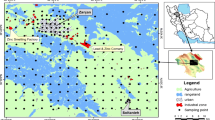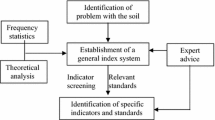Abstract
This research presents an evaluation system and model for optimizing phytoremediation on petroleum and heavy metal contaminated soils to simplify the methods, reduce the costs, and minimize the use of long-term tests in the phytoremediation process. The proposed evaluation system consists of Structural Equation Modeling (SEM) and the Analytic network process (ANP) and includes three criteria and twelve sub-criteria. The calculated weights indicated that plant species and soil texture were the most influential factors in phytoremediation, with loading factors of 0.910 and 0.876, respectively. Seven dominant plants from the study area were used as alternative plants for phytoremediation, and the highest weight of ranking alternative (0.201) suggested that Medicago sativa L (Alfalfa) could be a suitable plant for this purpose and that the suitable texture of the soil would be sandy clay loam for the phytoremediation measure. Sensitivity analysis confirmed that the combination of the ANP and SEM in this course was impartial and attainable. The application of structural equation modeling and multi-criteria decision methods were found to be effective since they could help diagnose not only the effects of soil texture on petroleum hydrocarbons reduction but also the impacts of selected plant species on heavy metals reduction as factors in phytoremediation inside the study area. Therefore, it was concluded that combined application of these two methods would provide an effective approach in monitoring contaminated sites for decision makers.






Similar content being viewed by others
References
Abdel-Moghny T, Mohamed RS, El-Sayed E, Mohammed Aly S, Snousy MG (2012) Effect of soil texture on remediation of hydrocarbons-contaminated soil at El-Minia district Upper Egypt. Int Scholar Res Notic 2012:406598
Abdullah L, Rahman NAA (2017) Analytic network process for developing relative weight of wastewater treatment technology selection. Modern Appl Sci 11(5):64–72
Aghelan N, Sobhanardakani S, Cheraghi M, Lorestani B, Merrikhpour H (2021) Evaluation of some chelating agents on phytoremediation efficiency of Amaranthus caudatus L. and Tagetes patula L. in soils contaminated with lead. J Environ Health Sci Eng 19(1):503–514
Alves WS, Manoel EA, Santos NS, Nunes RO, Domiciano GC, Soares MR (2018) Phytoremediation of polycyclic aromatic hydrocarbons (PAH) by cv. Crioula: a Brazilian alfalfa cultivar. Int J Phytoremediat 20(8):747–755
Amellal N, Portal JM, Vogel T, Berthelin J (2001) Distribution and location of polycyclic aromatic hydrocarbons (PAHs) and PAHdegrading bacteria within polluted soil aggregates. Biodegradation 12:49–57
Anderson J, Gerbing D (1988) Structural equation modeling in practice: a review of recommended two-step approach. Psychol Bull 103:411–423
Angelini ME, Heuvelink GBM, Kempen B, Morrás HJM (2016) Mapping the soils of an Argentine Pampas region using structural equation modelling. Geoderma 281:102–118
Anh BT, Kim DD, Kuschk P, Tua TV, Hue NT, Minh NN (2013) Effect of soil pH on as hyperaccumulation capacity in fern species. Pityrogramma Calomelanos J Environ Biol 34(2):23
Anyasi RO, Atagana HI (2018) Profiling of plants at petroleum contaminated site for phytoremediation. Int J Phytoremediat 20(4):352–361
Bai L, Luo Y, Shi D, Xie X, Liu L, Zhou Y et al (2015) Topsis-based screening method of soil remediation technology for contaminated sites and its application. Soil Sediment Contam 24(4):386–397
Beaumelle L, Vile D, Lamy I, Vandenbulcke F, Gimbert F, Hedde M (2016) A structural equation model of soil metal bioavailability to earthworms: confronting causal theory and observations using a laboratory exposure to field-contaminated soils. Sci Total Environ 569–570:961–972
Bremner JM, Mulvaney CS (1982) Nitrogen total. In: Page AL, Miller RH, Keeney DR (eds) Methods of soil analysis. Part 2. Chemical analysis. pp 595–24
Chen K, Jiao JJ, Huang J, Huang R (2007) Multivariate statistical evaluation of trace elements in groundwater in a coastal area in Shenzhen. China Environ Pollut 147(3):771–780
Chin WW (1998) The partial least squares approach for structural equation modeling. In: Marcoulides GA (ed) Methodology for business and management. Modern methods for business research Lawrence Erlbaum Associates Publishers, Mahxah, NJ, US, pp 295–336
Davodpour R, Sobhanardakani S, Cheraghi M, Abdi N, Lorestani B (2019) Honeybees (Apis mellifera L.) as a potential bioindicator for detection of toxic and essential elements in the environment (Case study: Markazi Province, Iran). Arch Environ Contam Toxicol 77(3):344–358
Eftekhari E, Mahdavi M (2019) Land suitability assessment using ANP in a GIS environment for tourism development site (Case study: Lavasan-e Kuchak Rural District, Tehran province, Iran). J Tourism Hospital Res 8(3):5–17
Figueiredo MA, PracaLeitea MG, Kozovitsb AR (2016) Influence of soil texture on nutrients and potentially hazardous elements in E. erythropap. Int J Phytorem 18(5):487–493
Fornell CG, Larcker DF (1981) Evaluating structural equation models with unobservable variables and measurement error. J Market Res 18(1):39–50
Ghiasvand AR, Yazdankhah F (2017) Single-step reinforced microextraction of polycyclic aromatic hydrocarbons from soil samples using an inside needle capillary adsorption trap with electropolymerized aniline/multi-walled carbon nanotube sorbent. J Chromatogr A 1487:47–53
Gouda AH, El-Gendy AS, Abd El-Razek TM, El-Kassas HI (2016) Evaluation of phytoremediation and bioremediation for sandy soil contaminated with petroleum hydrocarbons. Int J Environ Sci Dev 7(7):490
Hair J, Anderson R, Tatham R, Black W (1998) Multivariate data analysis, 5th edn. Prentice Hall, Upper Saddle River, NJ
Hair JF Jr, Sarstedt M, Hopkins L, Kuppelwieser VG (2014) Partial least squares structural equation modeling (PLS-SEM): an emerging tool in business research. Eur Bus Rev 26(2):106–121
Hair Jr JF, Hult GTM, Ringle C, Sartedt M (2013) A primer on partial least squares structural equation modeling (PLS-SEM). SAGE Publications, Incorporated
Hajabbasi MA (2016) Importance of soil physical characteristics for petroleum hydrocarbons phytoremediation: a review. Afr Environ Sci Technol 10(11):394–405
Hosseinpur AR, Motaghian HR (2015) Evaluating of many chemical extractants for assessment of Zn and Pb uptake by bean in polluted soils. J Soil Sci Plant Nutr 15(1):24–34
Jain VK, Gupta VK, Sharma LK (2014) Comparative studies of physico-chemical properties of the roadside soil at Morena-(M.P.). Curr World Environ 9:220–222
Jayasooriya VM, Muthukumaran S, Ng AWM, Perera BJC (2018) Multi criteriadecision making in selecting stormwater management green infrastructure for industrial areas part 2: a case study with topsis. Water Res Manag 8:1–16
Jonsson M, Wardle DA (2010) Structural equation modelling reveals plant-community drivers of carbon storage in boreal forest ecosystems. Biol Lett 6(1):116–119
Kebonye NM, Eze PN, Ahado SK, John K (2020) Structural equation modeling of the interactions between trace elements and soil organic matter in semiarid soils. Int J Environ Sci Technol 17(4):2205–2214
Kock N, Hadaya P (2018) Minimum sample size estimation in PLS-SEM: the inverse square root and gamma-exponential methods. Inform Syst J 28(1):227–261
Li BY, Zhou DM, Cang L, Zhang HL, Fan XH, Qin SW (2007) Soil micronutrient availability to crops as affected by long-term inorganic and organic fertilizer applications. Soil Tillage Res 96(1):166–173
Lindsay WL, Norvell WA (1987) Development of a DTPA soil test for zinc, iron, manganese, and copper. Soil Sci Soc Am J 42(3):421–428
Marinescu M, Toti M, Dumitru M, Ignat P, Anghel A, Marinescu M (2010) Soil pollution with crude oil-A case study in Braila County. Vol. LIII, ISSN 1222-5339. Agrochemistry and Environmental Protection of Bucharest Scientific Papers, Series A, UASVM Bucharest.
Mohebian M, Sobhanardakani S, Taghavi L, Ghoddousi J (2021) Analysis and potential ecological risk assessment of heavy metals in the surface soils collected from various land uses around Shazand Oil Refinery Complex, Arak. Iran Arab J Geosci 14(19):1–16
Mustapha A, Aris AZ (2012) Multivariate statistical analysis and environmental modeling of heavy metals pollution by industries. Pol J Environ Stud 21(5):1353–1361
Nekhay O, Arriaza M, Boerboom L (2009) Evaluation of soil erosion risk using analytic network process and GIS: a case study from Spanish mountain olive plantations. J Environ Manage 90(10):3091–3104
Okparanma RN, Ukpenevi SE, Ayotamuno JM (2018) Analytic network process in petroleum hydrocarbon decontamination management in Nigeria. J Eng Technol Res 10(4):26–37
Promentilla MAB, Furuichi T, Ishii K, Tanikawa N (2006) Evaluation of remedial countermeasures using the analytic network process. Waste Manag 26(12):1410–1421
Rhoades JD (1996) Salinity: Electrical conductivity and total dissolved solids. In: Method soil anal: part 3 chem method 5:417–435.
Saedi AM, Majid AA, Isa Z (2020) Relationships between safety climate and safety participation in the petroleum industry: a structural equation modeling approach. Saf Sci 121:240–248
Satty TL (1996) Decision making with dependence and feedback: the analytic network process. RWS Publication
Şener Ş, Sener E, Karagüzel R (2011) Solid waste disposal site selection with GIS and AHP methodology: a case study in Senirkent-Uluborlu (Isparta) Basin, Turkey. Environ Monit Assess 173(1):533–554
Sevkli M, Oztekin A, Uysal O, Torlak G, Turkyilmaz A, Delen D (2012) Development of a fuzzy ANP based SWOT analysis for the airline industry in Turkey. Expert Syst Appl 39(1):14–24
Sha Z, Xie Y, Tan X, Bai Y, Li J, Liu X (2017) Assessing the impacts of human activities and climate variations on grassland productivity by partial least squares structural equation modeling (PLS-SEM). J Arid Land 9(4):473–488
Sharma BD, Harsh A, Raj K, Nayyar VK (2004) Relationships between soil characteristics and total and DTPA-extractable micronutrients in inceptisols of Punjab. Commun Soil Sci Plant Anal 35(5–6):799–818
Sobhanardakani S (2018) Human health risk assessment of Cd, Cu, Pb and Zn through consumption of raw and pasteurized cow’s milk. Iran J Public Health 47(8):1172–1180
Walkley A, Black IA (1934) An examination of the Degtjareff method for determining soil organic matter, and a proposed modification of the chromic acid titration method. Soil Sci 37(1):29–38
Wang B, Xie HL, Ren HY, Li X, Chen L, Wu BC (2019) Application of AHP, TOPSIS, and TFNs to plant selection for phytoremediation of petroleum-contaminated soils in shale gas and oil fields. J Clean Prod 233:13–22
Wong KK (2013) Partial least squares structural equation modeling (PLS-SEM) techniques using SmartPLS. Mark Bull 24:1–32
Yan X, Liu M, Zhong J, Guo J, Wu W (2018) How human activities affect heavy metal contamination of soil and sediment in a long-term reclaimed area of the Liaohe River Delta, North China. Sustainability 10:338
Zahermand S, Vafaeian M, Bazyar MH (2019) Ability of Alfalfa plant to refine soil contaminated with nickel and lead. J Environ Sci Technol. https://doi.org/10.22034/JEST.2019.31761.4031.(InPersian)
Zhao X, Li Y, Song H, Jia Y, Liu J (2020) Agents affecting the productivity of pine plantations on the loess plateau in China: a study based on structural equation modeling. Forests 11(12):1328
Zhu H, Zhao Y, Nan F, Duan Y, Bi R (2016) Relative influence of soil chemistry and topography on soil available micronutrients by structural equation modeling. J Soil Sci Plant Nutr 16(4):1038–1051
Acknowledgements
The authors are grateful to the Science and Research Branch, Islamic Azad University for providing facilities to conduct and complete this study.
Funding
Not applicable.
Author information
Authors and Affiliations
Contributions
All authors contributed to the study conception and design. Material preparation, data collection and analysis were performed by [Mandana Mohebian], [Soheil Sobhan Ardakani], [Lobat Taghavi] and [Jamal Ghoddousi]. The first draft of the manuscript was written by [Mandana Mohebian] and [Soheil Sobhan Ardakani] and all authors commented on previous versions of the manuscript. The corresponding author ensuring that all listed authors have approved the manuscript before submission, including the names and order of authors.
Corresponding author
Ethics declarations
Conflict of interest
The authors declare that they have no conflict of interest.
Ethical Approval and consent to participate
This research does not contain any studies with animals and human subjects. The authors confirm that all the research meets ethical guidelines and adheres to the legal requirements of the study country.
Consent for publication
The authors declare that this manuscript does not contain any individual person’s data and material in any form.
Additional information
Editorial responsibility: Jing Chen.
Supplementary Information
Below is the link to the electronic supplementary material.
Rights and permissions
About this article
Cite this article
Mohebian, M., Sobhanardakani, S., Taghavi, L. et al. Optimization of phytoremediation of contaminated soil with heavy metals and petroleum hydrocarbons using SEM and MCDM techniques. Int. J. Environ. Sci. Technol. 19, 9535–9548 (2022). https://doi.org/10.1007/s13762-022-04311-8
Received:
Revised:
Accepted:
Published:
Issue Date:
DOI: https://doi.org/10.1007/s13762-022-04311-8




